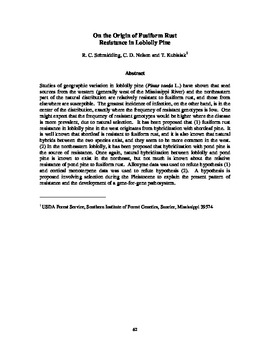| dc.contributor.author | Schmidtling, R. C. | |
| dc.contributor.author | Nelson, C. D. | |
| dc.contributor.author | T. Kubisiak | |
| dc.date.accessioned | 2016-04-25T19:35:57Z | |
| dc.date.available | 2016-04-25T19:35:57Z | |
| dc.date.issued | 2003 | |
| dc.identifier | oksd_sf27_p062.pdf | |
| dc.identifier.citation | Schmidtling, R. C., Nelson, C. D., & Kubisiak, T., (2003). "On the Origin of Fusiform Rust Resistance in Loblolly Pine." In 27th Southern Forest Tree Improvement Conference, Stillwater, OK | |
| dc.identifier.uri | https://hdl.handle.net/11244/33662 | |
| dc.description.abstract | Studies of geographic variation in loblolly pine (Pinus taeda L.) have shown that seed sources from the western (generally west of the Mississippi River) and the northeastern part of the natural distribution are relatively resistant to fusiform rust, and those from elsewhere are susceptible. The greatest incidence of infection, on the other hand, is in the center of the distribution, exactly where the frequency of resistant genotypes is low. One might expect that the frequency of resistant genotypes would be higher where the disease is more prevalent, due to natural selection. It has been proposed that (1) fusiform rust resistance in loblolly pine in the west originates from hybridization with shortleaf pine. It is well known that shortleaf is resistant to fusiform rust, and it is also known that natural hybrids between the two species exist, and they seem to be more common in the west. (2) In the northeastern loblolly, it has been proposed that hybridization with pond pine is the source of resistance. Once again, natural hybridization between loblolly and pond pine is known to exist in the northeast, but not much is known about the relative resistance of pond pine to fusiform rust. Allozyme data was used to refute hypothesis (1) and cortical monoterpene data was used to refute hypothesis (2). A hypothesis is proposed involving selection during the Pleistocene to explain the present pattern of resistance and the development of a gene-for-gene pathosystem. | |
| dc.format | application/pdf | |
| dc.language | en_US | |
| dc.relation.ispartofseries | Sponsored publication . . . of the Southern Forest Tree Improvement Committee ; no. 49 | |
| dc.rights | This paper is made available through open access and the auspices of the fair use doctrine for scholarly, educational and research purposes while recognizing the publisher already offers a free online version. The OSU Library�s intent is to offer access and preserve publications involving its faculty contributions. Contact the Digital Resources and Discovery Services at lib-dls@okstate.edu or 405-744-9161 for the permission policy on the use, reproduction or distribution of this material. | |
| dc.source | Proceedings of the 27th Southern Forest Tree Improvement Conference, volume 27, 2003. Editor, Craig R. McKinley. | |
| dc.title | On the Origin of Fusiform Rust Resistance in Loblolly Pine | |
| dc.type | text | |
| osu.filename | oksd_sf27_p062.pdf | |
| dc.type.genre | Conference proceedings | |
| dc.description.scopeandcontents | Papers and abstracts from the 27th Southern Forest Tree Improvement Conference held at Oklahoma State University in Stillwater, Oklahoma on June 24-27, 2003. | |
